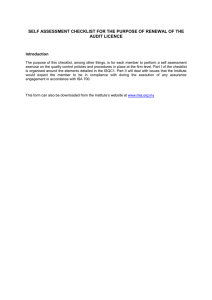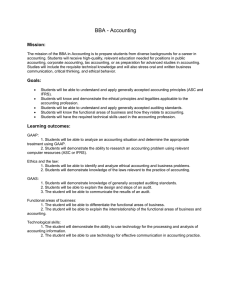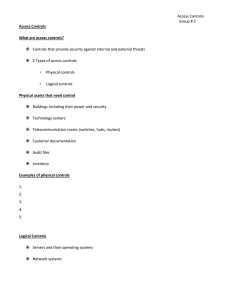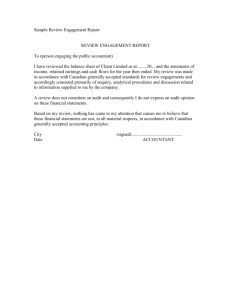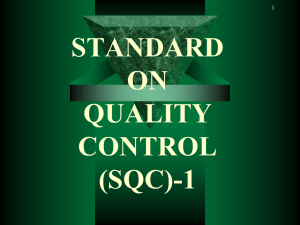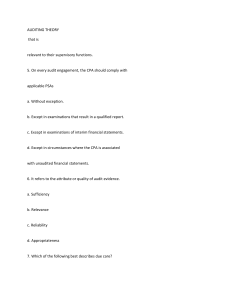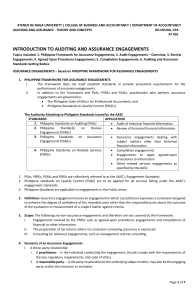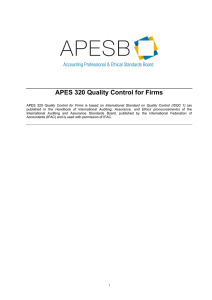Mr. SC Mohanty
advertisement
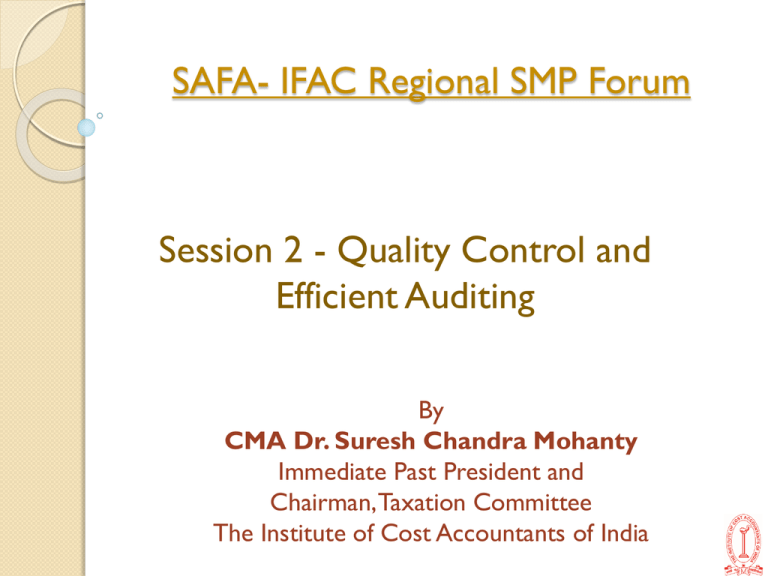
SAFA- IFAC Regional SMP Forum Session 2 - Quality Control and Efficient Auditing By CMA Dr. Suresh Chandra Mohanty Immediate Past President and Chairman, Taxation Committee The Institute of Cost Accountants of India Quality Control and Efficient Auditing Audit quality refers to the quality of audit outcome. Audit efficiency implies increased profitability. It is appropriate to take an integrated approach for improving audit quality and audit efficiency. Quality Control and Efficient Auditing A system of quality control in efficient auditing consists of policies designed to provide reasonable assurance that: The firm and its personnel comply with professional standards and applicable legal and regulatory requirements; Reports issued by the firm or engagement partners are appropriate in the circumstances; Appropriate procedures necessary to implement and monitor compliance with those policies exist; Elements of a System of Quality Control The firm shall establish and maintain a system of quality control that includes policies and procedures that address each of the following elements: Leadership responsibilities for quality within the firm. Relevant ethical requirements. Acceptance and continuance of client relationships and specific engagements. Human resources. Engagement performance. Monitoring. The firm shall document its policies and procedures and communicate them to the firm’s personnel. Automation Elements of a System of Quality Control In general, communication of quality control policies and procedures to firm personnel includes a description of the quality control policies and procedures and the objectives they are designed to achieve, and the message that each individual has a personal responsibility for quality and is expected to comply with these policies and procedures. Encouraging firm personnel to communicate their views or concerns on quality control matters recognizes the importance of obtaining feedback on the firm’s system of quality control. Leadership responsibilities for quality within the firm The firm’s leadership and the examples it sets significantly influence the internal culture of the firm. The promotion of a quality-oriented internal culture depends on clear, consistent and frequent actions and messages from all levels of the firm’s management that emphasize the firm’s quality control policies and procedures, and the requirement to: Perform work that complies with professional standards and applicable legal and regulatory requirements; and Issue reports that are appropriate in the circumstances. Such actions and messages encourage a culture that recognizes and rewards high quality work. These actions and messages may be communicated by, but are not limited to, training seminars, meetings, formal and informal communications. Relevant Ethical Requirements The firm shall establish policies and procedures designed to provide it with reasonable assurance that the firm and its personnel comply with relevant ethical requirements. The IESBA Code establishes the fundamental principles of professional ethics, which include: Integrity; Objectivity; Professional competence and due care; Confidentiality; and Professional behavior Acceptance and Continuance of Client Relationships and Specific Engagements The firm shall establish policies and procedures for the acceptance and continuance of client relationships and specific engagements, designed to provide the firm with reasonable assurance that it will only undertake or continue relationships and engagements where the firm: Is competent to perform the engagement and has the capabilities, including time and resources, to do so; Can comply with relevant ethical requirements; and Has considered the integrity of the client, and does not have information that would lead it to conclude that the client lacks integrity Human Resources The firm shall establish policies and procedures designed to provide it with reasonable assurance that it has sufficient personnel with the competence, capabilities, and commitment to ethical principles necessary to: Perform engagements in accordance with professional standards and applicable legal and regulatory requirements; and Enable the firm or engagement partners to issue reports that are appropriate in the circumstances. Human Resources Firm personnel have knowledge of relevant industries or subject matters: Firm personnel have experience with relevant regulatory or reporting requirements, or the ability to gain the necessary skills and knowledge effectively; The firm has sufficient personnel with the necessary competence and capabilities; Experts are available, if needed; Individuals meeting the criteria and eligibility requirements to perform engagement quality control review are available, where applicable; and Human Resources Personnel issues relevant to the firm’s policies and procedures related to human resources include, for example: Recruitment. Performance evaluation. Capabilities, including time to perform assignments. Competence. Career development. Promotion. Compensation. The estimation of personnel needs. Engagement Performance The firm shall establish policies and procedures designed to provide it with reasonable assurance that engagements are performed in accordance with professional standards and applicable legal and regulatory requirements, and that the firm or the engagement partner issue reports that are appropriate in the circumstances. Such policies and procedures shall include: Matters relevant to promoting consistency in the quality of engagement performance; Supervision responsibilities; Review responsibilities Engagement Performance A review consists of consideration of whether: The work has been performed in accordance with professional standards and applicable legal and regulatory requirements; Significant matters have been raised for further consideration; Appropriate consultations have taken place and the resulting conclusions have been documented and implemented; There is a need to revise the nature, timing and extent of work performed; The work performed supports the conclusions reached and is appropriately documented; The evidence obtained is sufficient and appropriate to support the report; and The objectives of the engagement procedures have been achieved. Documentation of the System of Quality Control The firm shall establish policies and procedures requiring; appropriate documentation to provide evidence of the operation of each element of its system of quality control. retention of documentation for a period of time sufficient to permit those performing monitoring procedures to evaluate the firm’s compliance with its system of quality control, or for a longer period if required by law or regulation. documentation of complaints and allegations and the responses to them. Confidentiality, Safe Custody, Integrity, Accessibility and Retrievability of Engagement Documentation Monitoring Monitoring the firm’s quality control policies and procedures The firm shall establish a monitoring process designed to provide it with reasonable assurance that the policies and procedures relating to the system of quality control are relevant, adequate, and operating effectively.This process shall: Include an ongoing consideration and evaluation of the firm’s system of quality control including, on a cyclical basis, inspection of at least one completed engagement for each engagement partner; Require responsibility for the monitoring process to be assigned to a partner or partners or other persons with sufficient and appropriate experience and authority in the firm to assume that responsibility; and Require that those performing the engagement or the engagement quality control review are not involved in inspecting the engagement Monitoring The purpose of monitoring compliance with quality control policies and procedures is to provide an evaluation of: Adherence to professional standards and applicable legal and regulatory requirements; Whether the system of quality control has been appropriately designed and effectively implemented; and Whether the firm’s quality control policies and procedures have been appropriately applied, so that reports that are issued by the firm or engagement partners are appropriate in the circumstances. Automation At the broad level both the audit quality and audit efficiency depends on the firm’s culture and use of technology. Automation reduces cost, of course in the long run, and improves the audit quality. Aim consistency across clients to achieve maximum benefits of automation. SMPs should explore the possibility of using Standard software. Generic firm template helps to reduce cost and improve quality. Every client is unique. Therefore, one should be cautious to incorporate unique features while developing template for each client. Conclusion An effective quality control policy and procedures adopted and sincerely implemented by an auditor / auditing firm will enable efficient auditing based on the tenets of accountability, fairness, transparency and independence. Thanks
